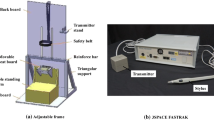Abstract
Accurate measurement of skin surface temperature is essential in both thermo-physiological and clinical applications. However, a literature review of the last two decades of physiological or clinical research revealed an inconsistency or a lack of information on how temperature sensors were attached to the skin surface. The purpose of this study was to systematically compare and quantify the performance of different commercially available temperature sensors and their typical attachment methods, and, secondly, to provide a time-efficient and reliable method for testing any sensor-tape combination. In conclusion, both the sensor type and the attachment method influenced the results of temperature measurements (both its absolute and relative dimensions). The sensor shape and the contact of its sensing area to the surface, as well as the conductance of the tape were the most important parameters to minimise the influence of environmental conditions on surface temperature measurement. These results suggest that temperature sensors and attachment methods for human subject and manikin trials should be selected carefully, with a systematic evaluation of the sensor-tape system under conditions of use, and emphasise the need to report these parameters in publications.



Similar content being viewed by others
References
Boetcher SKS, Sparrow EM, Dugay MV (2009) Characteristics of direct-contact, skin-surface temperature sensors. Int J Heat Mass Transf 52(15–16):3799–3804
Buono MJ, Ulrich RL (1998) Comparison of mean skin temperature using 'covered' versus 'uncovered' contact thermistors. Physiol Meas 19(2):297–300
Buono MJ, Jechort A, Marques R, Smith C, Welch J (2007) Comparison of infrared versus contact thermometry for measuring skin temperature during exercise in the heat. Physiol Meas 28(8):855–859
Cheung SS, Seweeney DH (2001) The influence of attachment method and clothing on skin temperature sensor accuracy. Med Sci Sports Exerc 33(5):161
Deng Z, Liu J (2008) Effect of fixing material on skin-contact temperature measurement by wearable sensor. 2008 5th International Summer School and Symposium on Medical Devices and Biosensors, 1-3 June 2008, Hong Kong, China, pp 137–140
Grgic G, Pusnik I (2011) Analysis of thermal imagers. Int J Thermophys 32(1–2):237–247
Harper Smith AD, Crabtree DR, Bilzon JLJ, Walsh NP (2010) The validity of wireless iButtons (R) and thermistors for human skin temperature measurement. Physiol Meas 31 (1):95–114
ISO9920 (2007) Ergonomics of the thermal environment—estimation of thermal insulation and water vapour resistance of a clothing ensemble
ISO11092 (1993) Textiles—physiological effects—measurement of thermal and water-vapour resistance under steady-state conditions (sweating guarded-hotplate test)
Jirak Z, Jokl M, Stverak J, Pechlat R, Coufalova H (1975) Correction factors in skin temperature measurement. J Appl Physiol 38(4):752–756
Karlsson H, Hanel SE, Nilsson K (1995) Evaluation of methods for measurement of regional skin temperature and heat flow in neonates. Acta Paediatr 84(6):599–603
Lichtenbelt WDV, Daanen HAM, Wouters L, Fronczek R, Raymann R, Severens NMW, Van Someren EJW (2006) Evaluation of wireless determination of skin temperature using iButtons. Physiol Behav 88(4–5):489–497
Mahanty DD, Roemer RB (1979) The effect of pressure on skin temperature measurements for a disk sensor. Trans ASME, J Biomech Eng 101(4):261–266
Matsukawa T, Ozaki M, Nishiyama T, Imamura M, Kumazawa T (2000) Comparison of infrared thermometer with thermocouple for monitoring skin temperature. Crit Care Med 28(2):532–536
Piekarski C, Kampmann B (1982) Zur Messung der Hauttemperatur mit Thermistorfühlern. Arbeitsmedizin Sozialmedizin Präventivmedizin 17(11):268–271
Psikuta A, Frackiewicz-Kaczmarek J, Frydrych I, Rossi RM (2012) Quantitative evaluation of air gap thickness and contact area between body and garment. Text Res J 82(14):1405–1413
Steketee J (1973) Spectral emissivity of skin and pericaredium. Phys Med Biol 18(5):686–694
Stoll AM, Hardy JD (1949) Direct experimental comparison of several surface temperature measuring devices. Rev Sci Instrum 20(9):678–686
Stoll AM, Hardy JD (1950) Study of thermocouples as skin thermometers. J Appl Physiol 2(10):531–543
Tyler CJ (2011) The effect of skin thermistor fixation method on weighted mean skin temperature. Physiol Meas 32(10):1541–1547
Wissler EH, Havenith G (2009) A simple theoretical model of heat and moisture transport in multi-layer garments in cool ambient air. Eur J Appl Physiol 105(5):797–808
Zaproudina N, Varmavuo V, Airaksinen O, Narhi M (2008) Reproducibility of infrared thermography measurements in healthy individuals. Physiol Meas 29(4):515–524
Acknowledgements
Part of this study was supported financially by EU project Prospie (FP7-NMP-229042). The authors thank the members of the Prospie consortium for making available some sensor systems and for their constructive feedback, and Dr. Veronika Meyer from Laboratory for Protection and Physiology at Empa for her editorial input.
Author information
Authors and Affiliations
Corresponding author
Rights and permissions
About this article
Cite this article
Psikuta, A., Niedermann, R. & Rossi, R.M. Effect of ambient temperature and attachment method on surface temperature measurements. Int J Biometeorol 58, 877–885 (2014). https://doi.org/10.1007/s00484-013-0669-4
Received:
Revised:
Accepted:
Published:
Issue Date:
DOI: https://doi.org/10.1007/s00484-013-0669-4




